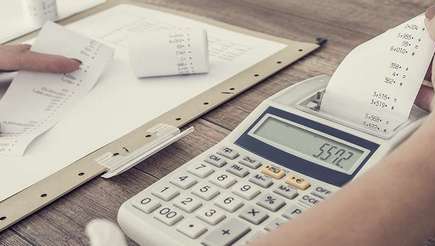Self-Assessment: a task that strikes fear into the hearts of Britain’s business owners, whether they’re well-seasoned or just starting out.
Submitting a Self-Assessment tax return at the end of each financial year is unavoidable if you’re self-employed – although this doesn’t stop some businesses from getting creative with their excuses for not filing.
And the 2017-2018 tax year was no exception – with excuses for missing the January 31st cut-off ranging from ‘my boiler had broken, and my fingers were too cold to type’ to ‘my mother-in-law is a witch and put a curse on me’.
Supernatural in-laws and sub-zero temperatures aside, submitting a Self-Assessment tax return really isn’t that scary. So, don’t get bogged down by the Self-Assessment tax return deadline dread.
Read AXA’s guide to the ins and outs of Self-Assessment tax returns to prevent being hit by hefty fines for tardy tax returns.
What is a Self-Assessment tax return?
Self-employed workers – including freelancers, owners of SMEs and contractors – are legally required to submit a physical or digital Self-Assessment tax return to HMRC each tax year (which run from 6 April to 5 April the following year).
Submitting a Self-Assessment tax return lets businesses report details of their taxable income and capital gains to HMRC and allows them to claim relevant tax allowances and reliefs.
HMRC then uses the information on business’ tax returns to calculate their tax bill and determine whether or not they’re due a tax refund.
Do I need to fill in a Self-Assessment tax return?
Wondering if you need to file a Self-Assessment tax return? As a rule of thumb, if you receive income that’s not taxed by deductions from your pay or pension under the Pay As You Earn (PAYE) system, then it’s highly likely that you’ll need to submit a Self-Assessment tax return at the end of each tax year.
For example, if you’re a sole trader who receives their income via invoices, it’s likely that you won’t have National Insurance contributions or Income Tax deducted from your earnings. As such, you’ll need to let HMRC know about this income by submitting a Self-Assessment tax return so that they can work out how much tax you owe.
Owners of limited companies and landlords who receive rent for letting out their properties are also required to submit Self-Assessment tax returns. But if you’re still unsure of your next step, why not use HMRC’s Self-Assessment tool to work out whether or not you’ll need to submit a tax return at the end of the next tax year?
How do I register for Self-Assessment?
Before you can submit a tax return, you need to register for Self-Assessment and Class 2 National Insurance with HMRC.
If you’ve sent a Self-Assessment tax return online before
If you’ve sent a return online before, you’ll need to re-register online using form CWF1 and have your ten-digit Unique Taxpayer Reference (UTR) at hand. If you’re unsure what your Unique Taxpayer Reference is, you can find it here.
If you haven’t sent a Self-Assessment tax return online before
If you’re registering online for the first time, HMRC will send you a letter with your ten-digit Unique Taxpayer Reference (UTR) and set up your account for the Self-Assessment online service after you’ve registered.
If you already have a UTR – for example, you may have sent a paper return before or registered by phone – create an account for the online service instead.
Once you’ve registered online, you’ll receive a letter that contains an activation code for your account within ten working days. Don’t worry if you lose or forget your activation code, you can always apply for a new one.
Other ways to register for Self-Assessment
As well as registering online, you can register for Self-Assessment by phone or by post. If you decide to register by post, you’ll need to complete and send off an SA1 form to HMRC.
Remember, whatever route you opt for, you’ll need to have your National Insurance number as well as your personal and business details ready to go.
Do I need to register for Self-Assessment every year?
Once you’ve registered, HMRC will remind you to send in a Self-Assessment tax return each year until you let them know that you no longer need to submit one (for example, you may decide to close your business or opt to work for another company).
If you’ve let HMRC know that you no longer need to submit Self-Assessment tax returns but start up another business venture further down the line, you’ll have to re-register for Self-Assessment and get a new Unique Taxpayer Reference (UTR).
What information will I need to fill out a Self-Assessment tax return?
As the saying goes: for every minute spent organising, an hour is earned. And when it comes to filing your Self-Assessment tax return, every second counts. Get ahead of the game by prepping the following paperwork before sitting down to sort out your Self-Assessment tax return:
- Salary – Use your P60 to record the income from your employment and the tax you paid
- Self-employment income – If you’re a sole trader, you’ll need to declare your income from self-employment against your allowable expenses
- Dividends
- Any rental income
- Pension contributions
- Payment on account – This is an advance payment towards your tax bill, which can be made at the end of January and July
- Gift aid
- P11D form – This provides HMRC with information on any taxable benefits provided by your employers e.g. private medical insurance
- Capital gains – You may have made a profit from selling business property or shares
What are the deadlines for submitting a Self-Assessment tax return?
Each tax year runs from 6 April to 5 April the following year. The Self-Assessment registration deadline is 5 October for each tax year and the deadline for online payment – and payment of tax owed – is 31 January of the following year.
For example, say you set up your own business in August 2019. You’re legally required to submit a Self-Assessment tax return for the tax year that runs April 6 2019 to April 5 2020. To stay in HMRC’s good books, you’d need to register for Self-Assessment by 5 October 2020 and submit your tax return – and pay any outstanding tax owed – by January 31 2021.
What are the penalties for missing the Self-Assessment tax return deadline?
The above may seem like a lot of dates to keep in mind but staying on top of your invoices and paperwork could help keep your wallet happier in the long run.
Missing the registration deadline of 5 October could result in you being fined, unless you can provide HMRC with valid reasons and still manage to submit your Self-Assessment tax return and pay any outstanding tax by 31 January.
However, the penalties for late tax returns are more severe and include the following:
- An initial £100 fixed penalty, which applies even if there is no tax to pay, or if the tax due is paid on time
- After three months, additional daily penalties of £10 per day, up to a maximum of £900
- After six months, a further penalty of 5% of the tax due or £300, whichever is greater
- After 12 months, another 5% or £300 charge, whichever is greater
- Additional penalties for paying late of 5% of the tax unpaid at 30 days, 6 months and 12 months.
HMRC can also punish businesses that they believe are deliberately not providing the necessary information or trying to conceal the true amount of tax they owe. If your business is found to be guilty of these activities, you could receive a fine of up to 100% of you tax liabilities on top of the penalties listed above.
How to fill out a Self-Assessment tax return
If you’ve managed to keep your business’ paperwork well-organised and up-to-date, then completing your Self-Assessment return should be easy.
But whether you’re a seasoned pro or a total newbie, keep the following advice in mind when you’re filling in your Self-Assessment tax return to ensure your stress levels are at a minimum.
Leave plenty of time
Try not to leave your tax return till the last minute. Haste makes waste, and you don’t want all your impeccable recordkeeping to be scuppered at the last minute due to the ticking clock of the 31 January deadline.
Handily, HMRC’s system lets you save your progress as you work your way through the form, meaning you can complete it in chunks instead of one fell swoop.
Ask for professional advice
Are your business’ finances complicated? Is it your first time submitting your Self-Assessment tax return and you’ve been left scratching your head?
If any of this sounds familiar, get in touch with financial experts and ask for advice on areas you’re having difficulty with. It’s better to seek the help of others than inputting incorrect information to meet a deadline and risk being fined.
Check, check and check again
Accuracy is vital when it comes to filing and submitting your Self-Assessment tax return. It goes without saying, but make sure you spend time double, triple and quadruple-checking each section of your tax return to help prevent being hit by fines later.
And once you’re totally happy with everything, take a deep breath and submit.
Congratulations, you’ve submitted a Self-Assessment tax return for another year!
As HMRC’s advert says, tax shouldn’t have to be taxing, and the same can be said for submitting a Self-Assessment tax return. This task has been hyped up to be something that businesses are taught to fear, but there’s no need to come up with your own elaborate excuses to shirk responsibility.
Keep your business’ finances and records in order and you’ll have no problem submitting your Self-Assessment tax return with plenty time to spare – leaving you with more to invest in making your business the best it can be.






